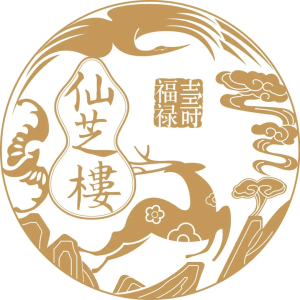
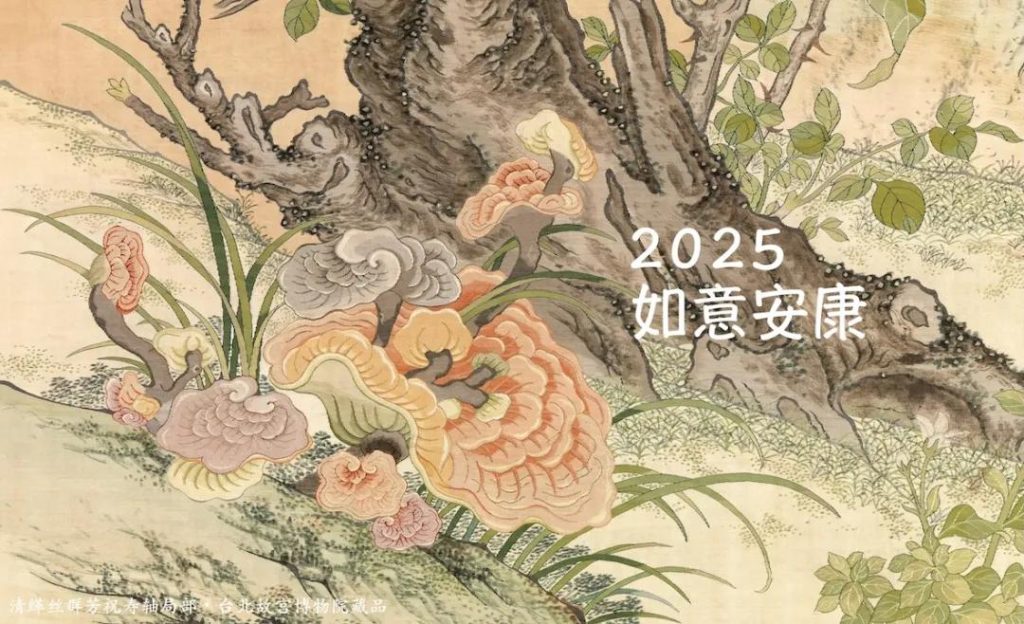
Древние китайские литературы и художники использовали разнообразные методы, чтобы изобразить Рейши. Один особенно интригующий подход включал в себя изображение Рейши, чтобы напоминать цветы, повторяя благословения здоровья и долголетия искусства. Альтернативно, При создании тем, сосредоточенных на сезонной флоре или множестве цветов, Они включали бы Рейши как еще один тип цветов. This practice seems to harness the auspicious connotations of Reishi, expressing a desire for perpetual blooms and enduring beautiful scenery.
A new year, a new beginning. Здесь, we share several treasured pieces from the Palace Museum collection, depicting Reishi painted to resemble flowers or incorporated as flowers themselves. Through these flower-like Reishi, let us bless ourselves and all under heaven: May 2025 bring you good fortune, здоровье, and peace!
Гриб Рейши, peach tree, monthly rose – lasting happiness and longevity.
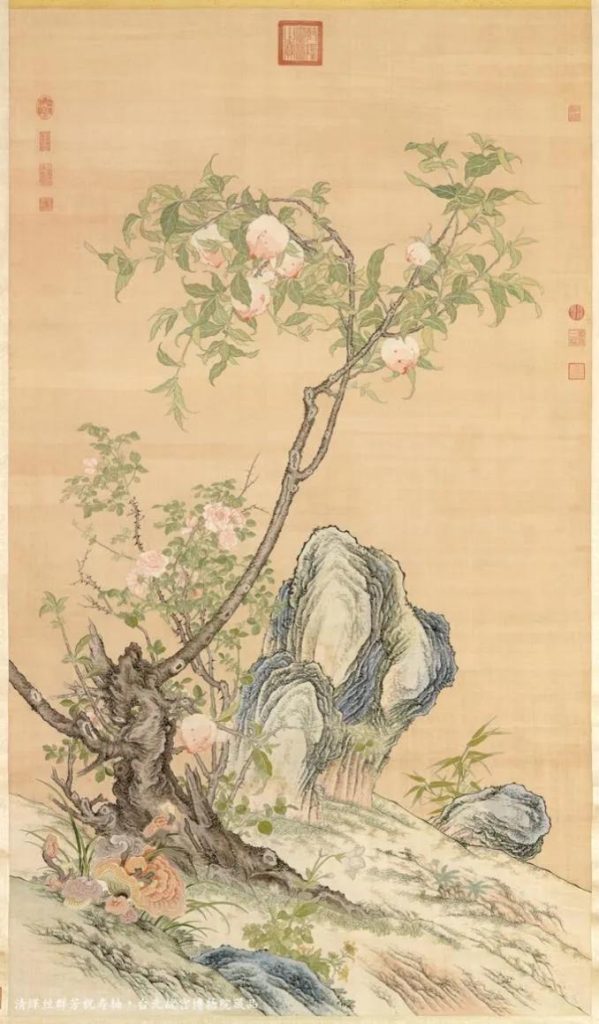
The Reishi mushroom illustration in the header of this article is taken from the lower left corner of this Qing dynasty silk tapestry, “A Celebration of Longevity with Myriad Flowers.” Gradually moving upward from the perspective of the red and purple Reishi mushrooms growing together, you will see: the monthly rose, which blooms throughout the four seasons and has the beautiful names of “queen of flowers,” the auspicious stone (longevity stone) symbolizing health and longevity, and the peach tree laden with fruit, representing the prosperity of descendants and lasting happiness and longevity. The Reishi mushroom, monthly rose, peach tree, and auspicious stone together perform “myriad flowers,” composing a musical movement of “celebrating longevity.”
Гриб Рейши, орхидея, daylily, cypress leaves – health and carefree.
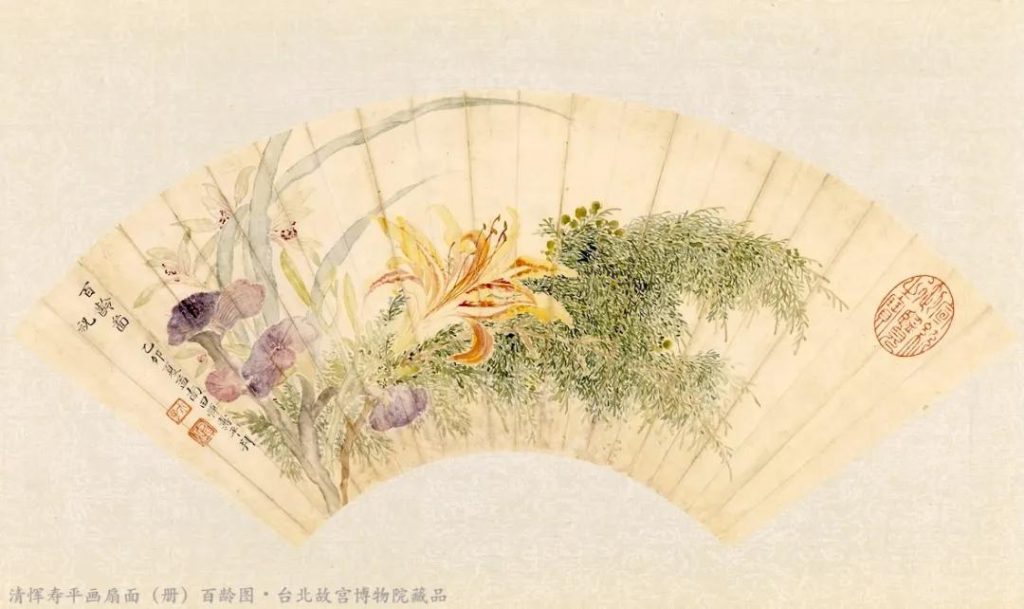
Этот “A Hundred Years” painting on a fan surface was created by the master of flower-and-bird painting in the early Qing dynasty, Yun Shouping, in the first month of summer (lunar April) of the 14th year of the Kangxi reign (1675). From right to left, he painted vibrant green cypress leaves, alternating yellow and orange daylilies, white and green orchids and orchid grass, and purple Reishi mushrooms. He aimed to offer the most beautiful blessings to the elegant orchid gentleman with the evergreen of cypress leaves, the carefree of daylilies, and the “польза для суставов, replenishing essence, укрепление мышц и костей, and improving complexion” of purple Reishi.
Рейши, orchid grass, and paradise flycatcher – prosperity, долголетие, and success.
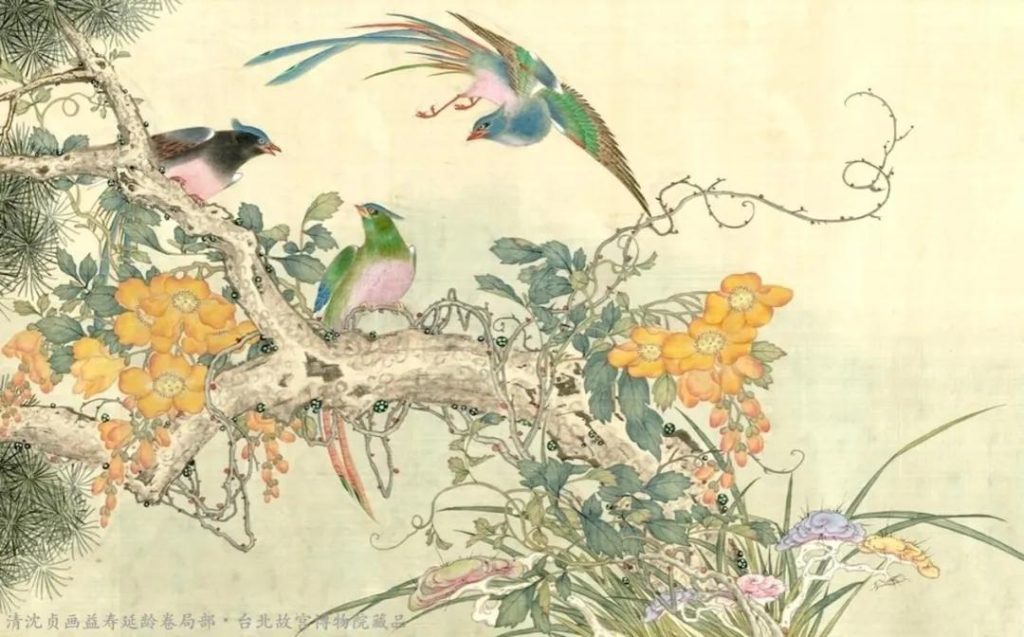
This image is the right half of the long scroll “Benefiting Longevity and Extending Life” by Shen Zhen, a court painter during the Guangxu period of the Qing dynasty. The flower-like Reishi is hidden among the orchid grass at the bottom of the painting. The two intertwine with the extending tree trunk to create the imagery of “Reishi and orchid, jade tree,” a metaphor for outstanding descendants. Together with the orange-red Chinese trumpet creeper, symbolizing lofty aspirations, they contribute to the depiction of the recipient’s status. The paradise flycatcher, with its long, flowing tail feathers reminiscent of the ribbons on official seals, carries auspicious connotations. Its name ( shòu dài niǎo) contains the character (shòu – ribbon), which shares a pronunciation with (shòu – долголетие), thus imbuing the bird with the dual meanings of “promotion and advancement” and “benefiting longevity and extending life.” This imagery conveys blessings for the recipient.
Рейши, Orchid, and Peach Blossom – Longevity and Immortality
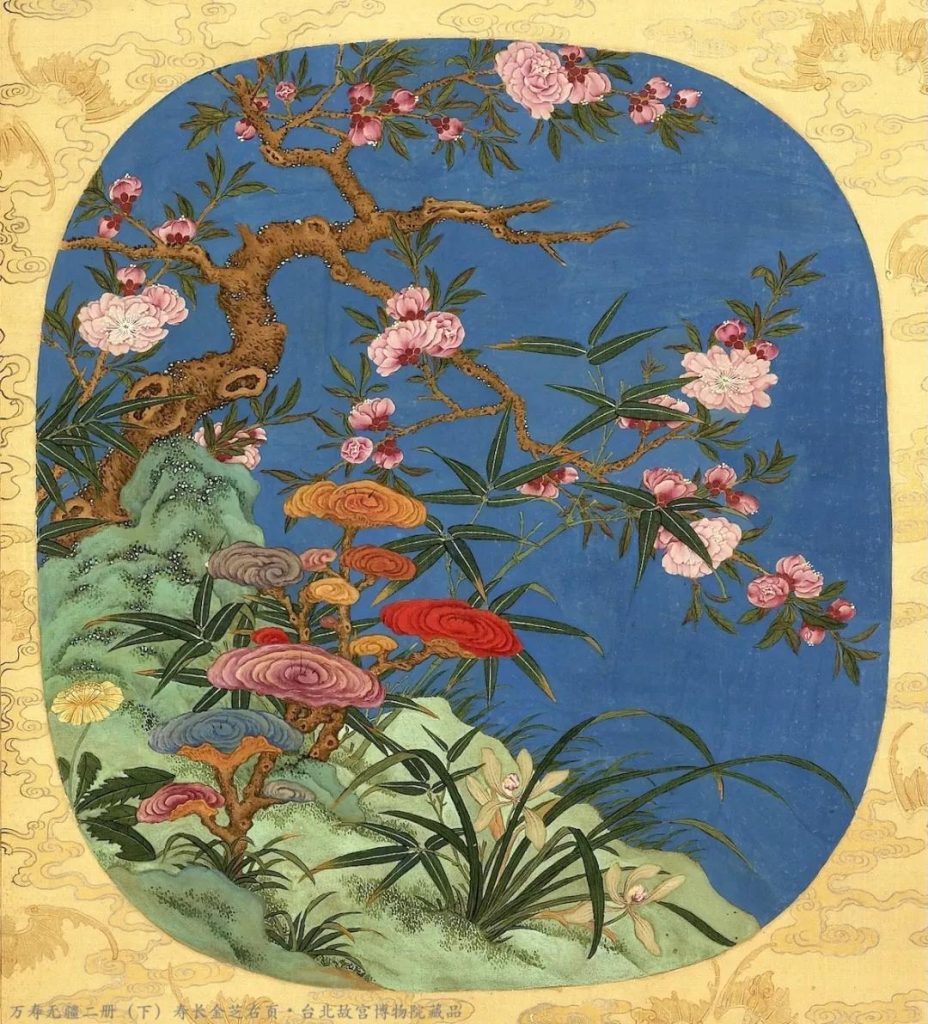
Taken from the album “Boundless Longevity” (с “Appreciation Seal of the Xuantong Emperor” on the book page), “Golden Reishi Bestowing Longevity” is one of 24 auspicious flower-and-plant paintings created by Qing dynasty court painters to celebrate the emperor’s birthday. In the painting, the protagonist dancing with the five-colored Reishi in the spring breeze is the prunus persica , which carries Taoist connotations of ascending to immortality. The accompanying couplet, a seven-character ancient poem, specifies that the depicted eternal spring paradise serves as an allegory for the effect of consuming Reishi for prolonged life and youthfulness.
From hallowed earth springs fortune’s radiant grace,
Five-hued mists nurture wonders of sacred space.
With nine-knotted staff, immortals trace their way,
Gold trays bear ageless wine from realms far away.
Behold the painter’s brush where spring blooms anew,
Revealing elixirs that celestial beings imbue.
With mystic power, age’s grip it can defy,
Like gentle breeze with rainbow clouds on high.
May the auspicious Reishi bring you joy, and may flowers always grace your days.
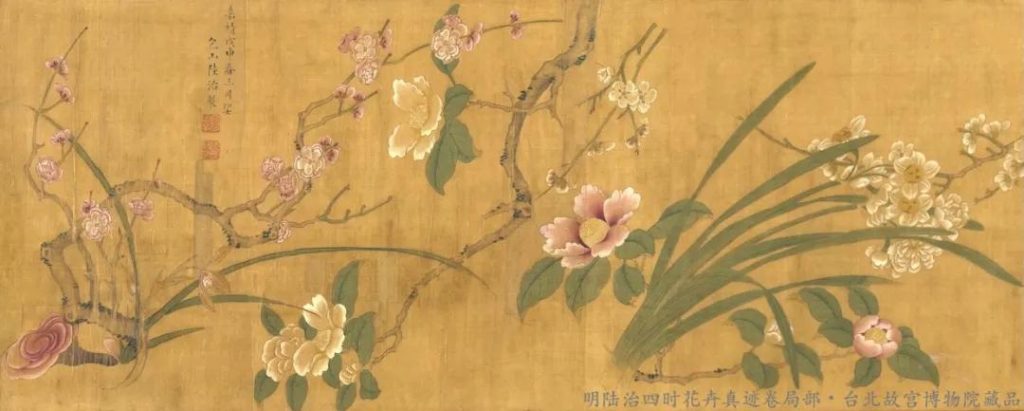
А “Hundred Flowers” painting, featuring seasonal flowers in a single long scroll, was a popular subject in the Ming and Qing dynasties. Lu Zhi, a Ming dynasty literati painter with a passion for gardening, also created several works of this kind, one of which is “True Depictions of Seasonal Flowers,” a nearly 500-centimeter-long scroll depicting over 30 varieties of cut flowers. This painting was created in the 27th year of the Jiajing reign (1548) when Lu Zhi was in his early fifties. Интересно, at the end of the painting (as shown in the image, from right to left), after completing the narcissus, pink camellia, white plum (green calyx plum), white camellia, and red plum (wax plum) in sequence, he concludes the entire painting with a flourishing, flower-like Reishi mushroom.
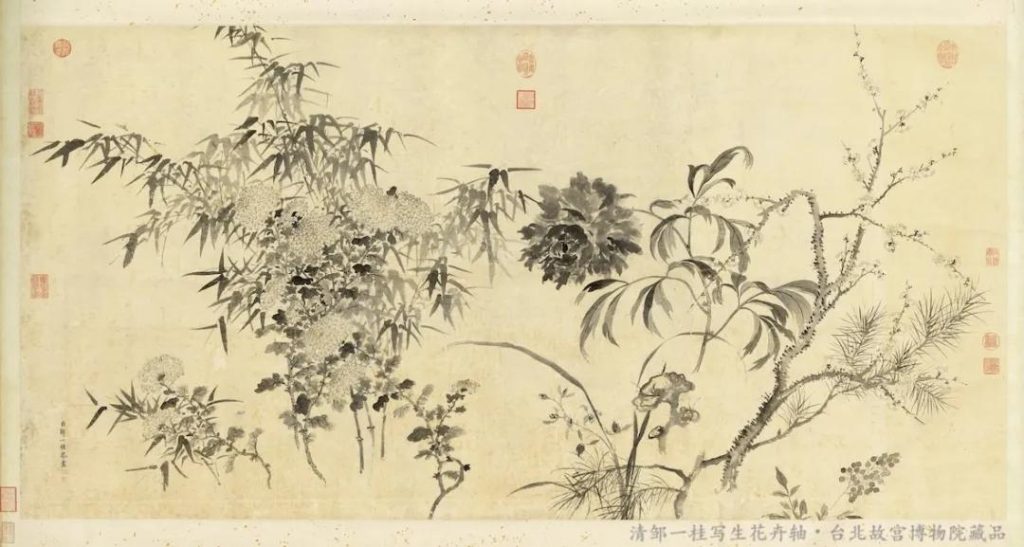
Случайно, the ink wash paintings of “Flowers and Plants from Life,” created by Zou Yigui, a court painter and poet active during the Qianlong period, also subtly incorporate a Reishi mushroom amidst the seasonal flowers and plants—including Indian jasmine (spring), Cymbidium (spring), peony (summer), chrysanthemum (autumn), and plum blossom (winter)—as well as pine and bamboo. Though rendered with a few simple strokes, the Reishi adds boundless charm.
In addition, two “Hundred Flowers” paintings, one in monochrome ink wash and the other in color ink wash, were completed by the late Ming Dynasty painter Zhou Zhimian during the Wanli period (spanning the late 16th and early 17th centuries). Both works, depicting dozens of flowers from all four seasons in long scrolls, feature Reishi mushrooms at their ends. Due to copyright restrictions, these paintings cannot be reproduced here for your viewing. Those interested may visit the Palace Museum in Beijing or the China Guardian website (relevant URLs are provided at the end of this article).
The combination of seasonal flowers and Reishi wasn’t a fixed formula, but rather entirely up to the painter’s inclination. The reason for such an inspired touch might be that the painters wished to borrow the auspicious symbolism of Reishi—longevity and enduring prosperity—and, within the natural order of the four seasons and the cycle of all things, express the human desire for “flowers that bloom forever and scenes that remain eternally beautiful.”
Flowers bloom in a flourishing age; may all your wishes be fulfilled and you enjoy peace and health.
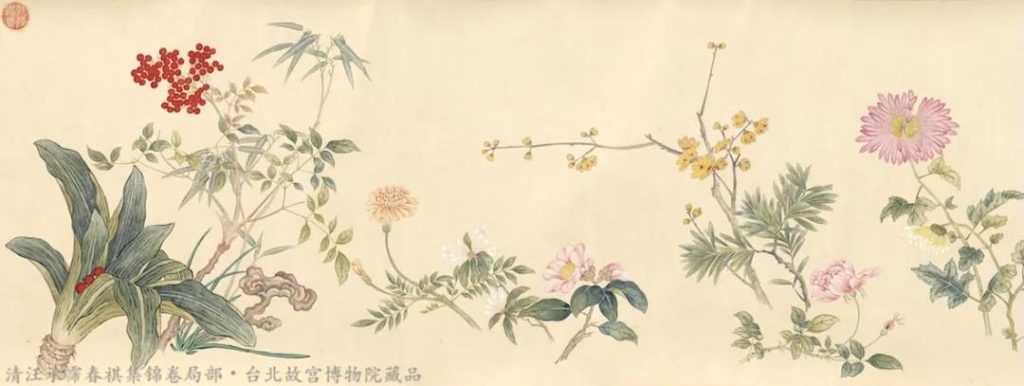
Сходным образом, Reishi was also incorporated into flower arrangements within the “Hundred Flowers” painting format. However, this particular work, “Spring Blessings Collection,” was commissioned by the Qianlong Emperor and painted by Wang Chengpei, then serving as the Left Vice Minister of the Ministry of Works (equivalent to today’s Deputy Minister of Transportation and Public Works). Unlike previous works that expressed natural rustic charm or personal emotions, this painting was created to honor the wise image of the Emperor.
This painting was completed on the sixth day of the first lunar month in the 49th year of the Qianlong reign (1784), half a month before before Emperor Qianlong’s sixth (and final) southern tour. This 3.8-meter-long scroll brings together the splendor of over 40 varieties of seasonal flowers, transcending the boundaries of spring, summer, autumn, and winter to bloom together in one place, depicting the prosperous and peaceful era of the current dynasty, with the nation secure and the people content. At the end of the painting (left side of the image), bamboo, homophonous with “blessing” , red fruits of the Nandina domestica symbolizing “auspiciousness and good fortune,” Rohdea japonica symbolizing “unified for ten thousand years” and “prosperity and peace in a flourishing age,” and Reishi in the shape of a Ruyi scepter are used to offer blessings to Qianlong as he is about to embark on his journey.
Flowers flourish, Reishi abounds, life knows no end.
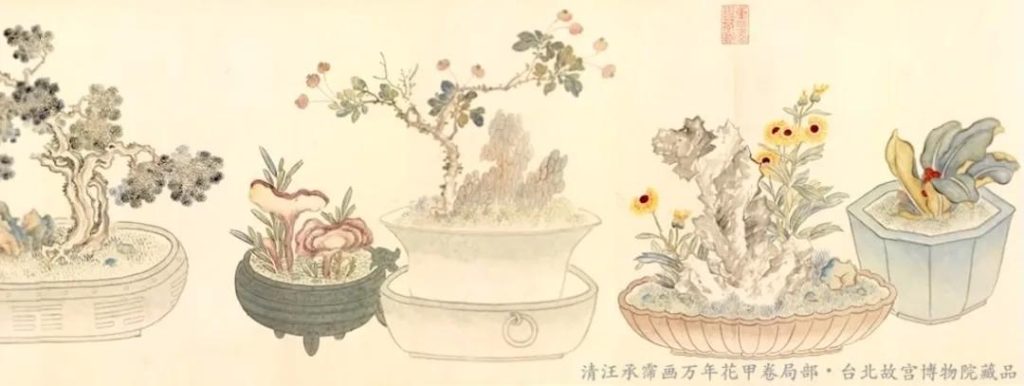
The story continues. On the 12th day of the intercalary third month of the same year, Emperor Qianlong, still on his way back to Beijing after concluding his southern tour, received the joyous news of the birth of his great-great-grandson. In that era, 74 years old was already considered advanced in years, let alone having five generations under one roof – this was a blessing that no previous emperor had ever enjoyed! Qianlong once again commissioned Wang Chengpei to express through his brushstrokes his gratitude to Heaven for bestowing him with health and longevity, as well as the prosperity of his family, and to pray for Heaven’s continued protection of the Qing Dynasty for ten thousand years.
Wang Chengpei, who was well attuned to the emperor’s intentions, lived up to expectations by completing *Painting of Ten Thousand Years of Huajia* in just over a month—a work even more monumental than the *Spring Blessings Collection*. Spanning a 5.5-meter-long scroll, the painting depicts 24 bonsai specimens, each meticulously cultivated, carefully pruned, and ingeniously arranged. Through the vibrant foliage and blossoms of seasonal plants, the artwork metaphorically celebrates the virtuous longevity of the people and the prosperity of families under Emperor Qianlong’s reign, attributing these blessings to the emperor’s far-reaching virtue and universal benevolence. Drawing on the traditional 60-year cycle of the Chinese sexagenary system (known as a *huajia* or *jiazi*), the painting is titled *Ten Thousand Years of Huajia*, symbolizing the eternal renewal of the nation’s fortune, the perpetual endurance of the dynasty, and the boundless longevity of the emperor.
Upon closer inspection of the Reishi bonsai in the painting, the rightmost one exhibits a concentric ring pattern on its Ruyi-shaped cap, while the central, taller one displays a milky white fruiting body, containing spores and about to open. On the far left, there is yet another Reishi, just emerging with a milky white primordial stalk. Such a meticulous depiction of the Reishi at different growth stages suggests that the Reishi in the painting is not merely a symbol of “when the virtue of the ruler reaches its zenith, the Reishi will flourish” and “when the ruler is benevolent, the Reishi will grow.” Rather, it reveals the artist’s observation of actual Reishi specimens in real life (rather than being based on imagination).
The operation of heaven and earth follows a natural order, with each flower blooming at its appointed time according to a set rhythm. However, flowers must be nurtured in order to bloom beautifully and last long; the same is true for humans. Only through constant care and maintenance can one live a long, healthy life.
May the resplendent Reishi, beyond its aesthetic charm, bring you a 2025 filled with joy, здоровье, and well-being. A life enriched by Reishi is truly extraordinary!
Main References
1. Jiang Youwen: The Stylistic Features and Evolution of Flower-themed Painting Scrolls. Daguan Нет. 137, п. 12, 2021.
2. Lin Lina: Auspiciousness of Hundred Flowers and Peace in a Prosperous Era: A Brief Study of Wang Chengpei’s “Spring Blessings Collection” and “Painting of Ten Thousand Years of Huajia”. The Palace Museum Cultural Relics Monthly Нет. 411, пп. 74-87, 2017.
3. [Ming Dynasty] Zhou Zhimian: Hundred Flowers Painting Scroll (Ink-and-Wash Painting), Collection of the Palace Museum, Пекин. https://www.dpm.org.cn/collection/paint/234612.html
4. [Ming Dynasty] Zhou Zhimian: Hundred Flowers Painting Scroll (Color Ink Painting), China Guardian 2021 Autumn Auction Exhibits. https://www.cguardian.com/auctions/item-detail?categoryId=GD-2021-CN006-008-014&itemCode=1194
КОНЕЦ
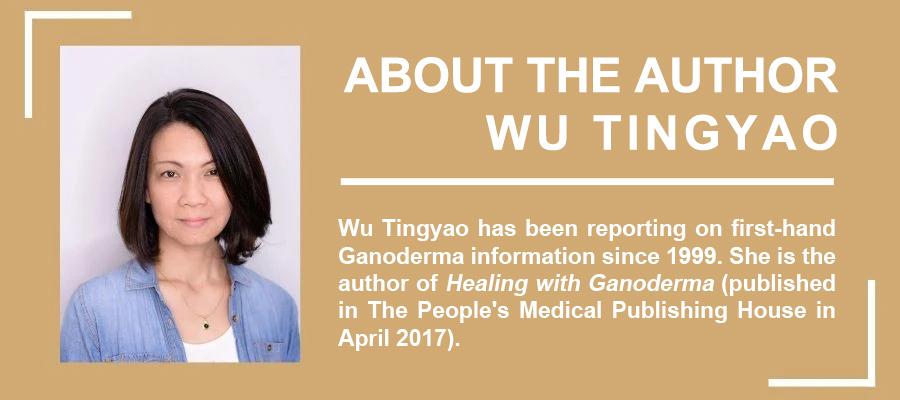
★ Эта статья разрешена исключительно автором публикации, и его право собственности принадлежит GanoHerb.
★ Вышеуказанные работы не могут быть воспроизведены, извлечено или использовано другими способами без разрешения GanoHerb.
★ Те, кто был уполномочен использовать работы, должны использовать их в рамках разрешения и указывать источник: ГаноХерб.
★ Ganoherb будет выполнять юридические обязанности против тех, кто нарушает вышеупомянутое заявление.
★ Первоначальная рукопись этой статьи была написана на китайском языке Уа Тиньяо и впоследствии переведена на английский язык Альфредом Лю. В случае любых несоответствий между английским переводом и оригинальным китайским текстом, Последний должен иметь приоритет. Для любых запросов, пожалуйста, обратитесь к первоначальному автору, РС. У Тинъяо.
